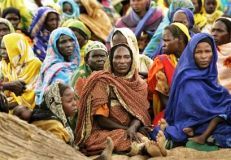10% jump in number of people in Darfur who need aid: UN
UNITED NATIONS, Oct 22, 2004 (UN News Centre) — The number of displaced people needing life-saving relief in the crisis-ridden western Sudan region of Darfur jumped 10 per cent in September alone, as international aid agencies hastened to keep pace with the new demands, the United Nations Emergency Relief Coordinator said today.
 The increase has meant that the number of conflict-affected persons requiring aid in Darfur rose to 2 million, or a third of the population, including both 1.6 internally displaced people (IDPs) and 400,000 affected people in place, from a total for both groups of 1.8 million in August, Jan Egeland said.
The increase has meant that the number of conflict-affected persons requiring aid in Darfur rose to 2 million, or a third of the population, including both 1.6 internally displaced people (IDPs) and 400,000 affected people in place, from a total for both groups of 1.8 million in August, Jan Egeland said.
The number excluded the 200,000 refugees who fled to neighbouring Chad, said the UN Office for the Coordination of Humanitarian Affairs (OCHA), which Mr. Egeland heads.
The Office of the UN High Commissioner for Refugees (UNHCR) said it would strengthen its operations in Darfur to take pressure off the resources of the local population around the 11 refugee camps in eastern Chad.
Already, one danger was that in eastern Chad, “one of the driest places on earth,” water supplies were being exhausted and finding water has been a big logistical problem. In Iridimi camp near Iriba, UNHCR said, “the water table is decreasing much faster than foreseen, with the current supply likely to last for only two more weeks.”
“We fear that if the situation is not stabilized soon in Darfur, we could see tens of thousands more refugees cross the border into Chad, where resources are already stretched to the breaking point and where there is growing animosity among the local population,” UNHCR said.
Within Darfur, an estimated 70 per cent of the conflict-affected population received food and 52 per cent received shelter and other critical survival items last month, OCHA said. About 40 per cent had clean water supplies, 42 per cent had available latrines and 67 per cent could go to primary health care facilities.
More than 6,000 national and international aid workers were distributing life-saving materials. “Aid agencies have made tremendous strides over the past month by boosting their presence on the ground and reaching more people living in previously inaccessible territory,” Mr. Egeland said.
